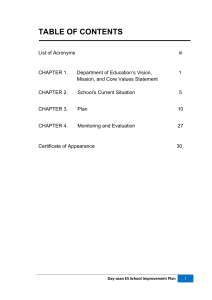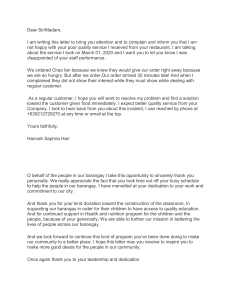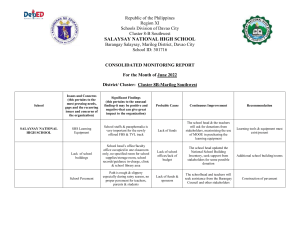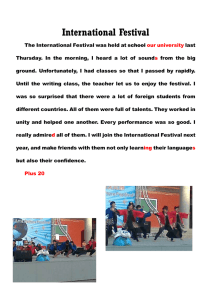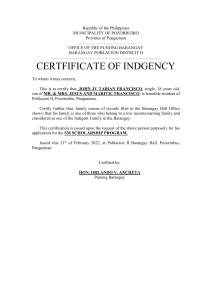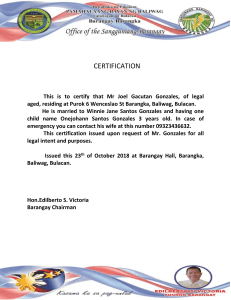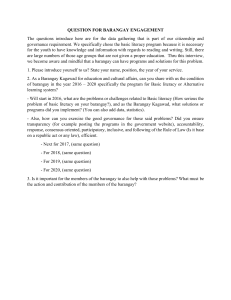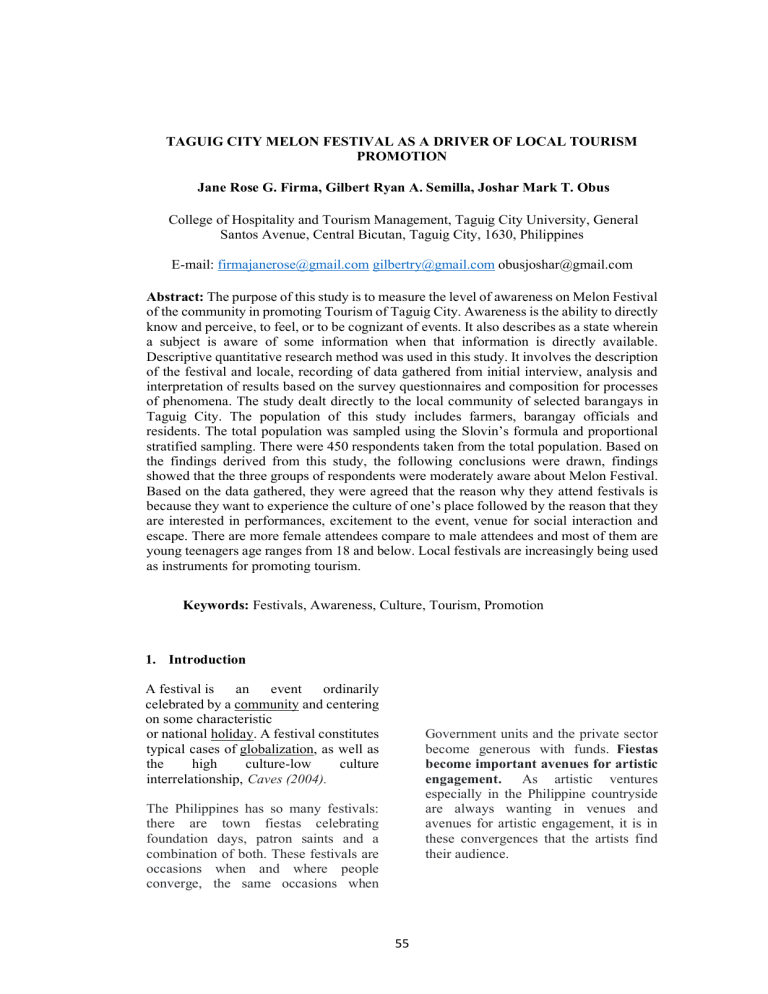
TAGUIG CITY MELON FESTIVAL AS A DRIVER OF LOCAL TOURISM PROMOTION Jane Rose G. Firma, Gilbert Ryan A. Semilla, Joshar Mark T. Obus College of Hospitality and Tourism Management, Taguig City University, General Santos Avenue, Central Bicutan, Taguig City, 1630, Philippines E-mail: firmajanerose@gmail.com gilbertry@gmail.com obusjoshar@gmail.com Abstract: The purpose of this study is to measure the level of awareness on Melon Festival of the community in promoting Tourism of Taguig City. Awareness is the ability to directly know and perceive, to feel, or to be cognizant of events. It also describes as a state wherein a subject is aware of some information when that information is directly available. Descriptive quantitative research method was used in this study. It involves the description of the festival and locale, recording of data gathered from initial interview, analysis and interpretation of results based on the survey questionnaires and composition for processes of phenomena. The study dealt directly to the local community of selected barangays in Taguig City. The population of this study includes farmers, barangay officials and residents. The total population was sampled using the Slovin’s formula and proportional stratified sampling. There were 450 respondents taken from the total population. Based on the findings derived from this study, the following conclusions were drawn, findings showed that the three groups of respondents were moderately aware about Melon Festival. Based on the data gathered, they were agreed that the reason why they attend festivals is because they want to experience the culture of one’s place followed by the reason that they are interested in performances, excitement to the event, venue for social interaction and escape. There are more female attendees compare to male attendees and most of them are young teenagers age ranges from 18 and below. Local festivals are increasingly being used as instruments for promoting tourism. Keywords: Festivals, Awareness, Culture, Tourism, Promotion 1. Introduction A festival is an event ordinarily celebrated by a community and centering on some characteristic or national holiday. A festival constitutes typical cases of globalization, as well as the high culture-low culture interrelationship, Caves (2004). Government units and the private sector become generous with funds. Fiestas become important avenues for artistic engagement. As artistic ventures especially in the Philippine countryside are always wanting in venues and avenues for artistic engagement, it is in these convergences that the artists find their audience. The Philippines has so many festivals: there are town fiestas celebrating foundation days, patron saints and a combination of both. These festivals are occasions when and where people converge, the same occasions when 55 The Philippine festival calendar is full. Every province, town and city celebrates foundation days, patronal fiestas and historic celebrations. While it is a hodgepodge and flurry of sports and commercial activities, oftentimes culture and the arts are the central motifs of the celebrations allowing artists to dare and engage in new projects. Depending on the local expertise, these fiestas become the stage for local visual arts, music and dance festivals. Cosmopolitan centers feature contemporary arts while others highlight traditions indigenous to the locale, Carino ( 2011). lighthouse, and with people whose virtue of pagtutulungan is still very much alive. The City of Taguig, (formerly spelled as Tagig), is a highly urbanized city located in south-eastern portion of Metro Manila in the Philippines. From a thriving fishing community along the shores of Laguna de Bay, it is now an important residential, commercial and industrial center. The recent construction of the C5 highway and the acquisition of the Fort Bonifacio Development Area has paved the way for the cityhood of the municipality. It will also be accessed by the future C-6 Road, Guia , (2012). According to the Census of Population (2015), Taguig is the seventh most populous city in the Philippines with a population of 804,915 people. Located in the western shores of Laguna de Bay, the city is known for the Bonifacio Global City, one of the leading financial centers of the Philippines. Originally a fishing village during the Spanish and American colonial periods, the municipality experienced rapid growth when former military reservations were converted by the Bases Conversion and Development Authority into mixed-use planned communities and financial centers. Taguig was converted from a municipality into a highly urbanized city with the passage of Republic Act No. 8487 in 2004. Taguig City, May 15 (PIA) -- The city government of Taguig recently launched its first-ever Melon festival at Taguig Melon Farm in Barangay Wawa giving due credit to the sweet fruit that symbolizes the hard work of Taguigeño farmers. During the event, Taguigeño families from different barangays had an exciting and fun-filled afternoon as they joined various games such as Melon Relay, Melon Eating, Father-and-Son Melon Run, and Shoot That Melon which uses the fruit as an essential part of the game. There were also performances of stilt walkers. Variety of melon products and refreshments such as melon pancakes, melon jam, melon doughnuts, melon puto, melon ice candies, and melon juice were also made available during the festival. In 2011, during 424th foundation day of Taguig, former Mayor (now Congresswoman) Lani Cayetano takes pride in calling the city a “ProbinSyudad” because it is the only remaining city in Metro Manila which has the amenities of a highly urbanized city, yet has the feel and relaxing atmosphere of a province plus its people exude the values and magandang asal of the probinsyano, what with its more than 10 kilometers of lakeshore, with farmers, fishermen, old churches, a historic Taguig City Mayor Lani Cayetano led the launching along with House Deputy Speaker and Taguig 2nd Dist. Rep. Pia Cayetano, Vice Mayor Ricardo “Ading” Cruz Jr. and other city officials. “This celebration is our way of gratitude to our Lord for providing continuous blessings to Taguig. We want to show everyone that despite our continuous progress as an 56 urbanized city, we do not forget our roots,” Cayetano said during the opening ceremonies. The city government through its City Agriculture Office provides technical assistance that includes the provision of Knapsack fourStroke Power Sprayers and distribution of free vegetable seeds to farmers in the city. Taguig continues to support the agricultural sector not just by providing Taguigeño farmers equipment but also creating a platform where they can exhibit the significance of the farming community and to promote the city’s homegrown products. South business districts, managed to retain 202 hectares of agricultural land used for cultivation of melon, rice and high-value crops like kinchay. The Taguig Integrated Urban Farm, which sits on a 2,500-square meter land beside Lakeshore Hall in Barangay Lower Bicutan was also launched last December 2017. The farm overlooking Laguna Lake integrates different kinds of urban farming setups—from gardens that showcase vertical farming that save space, to wooden rack and pole gardens. Guzman, (2018) This research will give further discussion and explanation about the community awareness and the related influence constructs on the basis of the research motivation and purpose. The purpose of this study is to measure also the level of awareness on Melon Festival to the community of Barangay Wawa to promote Tourism of Taguig. Besides, for measuring awareness, it should be done according to the models. Awareness is the ability to directly know and perceive, to feel, or to be cognizant of events. Generally speaking, it is the state of being conscious of something. The City Agriculture Office also conducts lectures, seminars and trainings regarding urban farming and gardening. “We are happy for the opportunity to promote our harvest. This will help us promote Taguig as the sole “Probinsyudad” in the Metro Manila and in return will help us in retain the remaining agricultural land in our city,” Cruz explained. Reynaldo Cruz, who is also the President of the Taguig Farmers Association. The rapidly developing city, home of the Bonifacio Global City and the ARCA 2. Methodology computational, statistical, and mathematical tools to derive results. It is conclusive in its purpose as it tries to quantify the problem and understand how prevalent it is by looking for projectable results to a larger population. This method also attempts to accurately describe the awareness level of individual or groups. Moreover, it may be defined as a purposive process of gathering analyzing classifying, and tabulating data about prevailing conditions, practices, beliefs, process, trends, and cause and effect relationships and then making adequate and accurate RESEARCH METHOD AND DESIGN This study utilized a descriptive research. A descriptive research is used to describe characteristics or population being interpreted. It involves the description, recording, analysis, and interpretation of the present nature, composition or processes of phenomena. The focus is on prevailing conditions, or how a person, group, or thing behaves or function in the present. Quantitative research it is a structured way of collecting and analyzing data obtained from different sources. Quantitative research involves 57 interpretation about such data with the aid of statistical method. POPULATION TECHNIQUE AND population of Brgy. Wawa is 128, Brgy. Bambang 115 and Brgy. Sta. Ana has 207 with a total population of 450 respondents. SAMPLING RESPONDENTS OF THE STUDY The study dealt directly to the local community of selected barangay in Taguig City. The population of the study includes farmers, barangay officials, and resident. This sampling method is conducted where each members of the population have an equal opportunity to become part of the sample. The sample The respondents of this study were the selected local community of Barangay Wawa, Barangay Bambang and Barangay Sta. Ana in Taguig City. The total population of each Barangay is as shows in the table and the researchers got the total of 450 respondents. 3. Tables TABLE I LEVEL OF MOTIVES OR REASONS OF RESPONDENTS FOR ATTENDING FESTIVAL IN TERMS OF EXCITEMENT LEGENDS: 4.00-3.50 = Strongly Agree 3.49-2.50 = Agree 2.49-1.50 = Moderately Agree 1.49-1.00 = Disagree 58 Barangay Wawa Indicators ̅ 𝒙 1. Motivated attend event/festival because excitement. V.I Barangay Ana V.I ̅ 𝒙 ̅ 𝒙 Sta. Total V.I ̅ 𝒙 V.I A 3 A 3.11 A 3.10 A 2.Excitement to the 3.13 event’s games/ activities. A 3.15 A 3.17 A 3.15 A 3.Excitement build memories. to 3.30 A 3.17 A 3.29 A 3.25 A 3.12 A 3.10 A 3.19 A 3.16 A Overall Mean to 3.20 an Barangay Bambang of Table I reveals that the most likely reason why people attended the festival was in terms of excitement to build memories with the highest total weighted mean of 3.25, followed by the lowest rank with 3.11 of motivated to attend an event/festival because of excitement. It was concluded on the study of Yuan et al. (2015) that the festival atmosphere attracted successfully to a large group of attendees who were motivated by the prospect of enjoying a fun experience to which a festival will provide a venue for them to relax and have fun TABLE II Barangay Wawa V.I A Barangay Bambang ̅ V.I 𝒙 3.30 A Barangay Sta. Total Ana ̅ V.I ̅ 𝒙 𝒙 3.14 A 3.25 V.I A A 3.16 A 3.29 A 3.19 A A 3.19 A 3.74 A 3.4 A Indicators ̅ 𝒙 4. Wants to 3.30 experience the culture of one’s place. 5. To 3.13 experience local food.. 6. To appreciate local 3.27 art, performances, 59 and diversity of culture. Overall Mean 3.23 A 3.22 A 3.39 A 3.28 A LEVEL OF MOTIVES OR REASONS OF RESPONDENTS FOR ATTENDING FESTIVAL IN TERMS OF CULTURAL EXPERIENCE Table II shows that the most likely reason why people attend festival in terms of cultural experience was that they wanted to experience the culture of one’s place with the highest total weighted mean of 3.25, followed by 3.19; to experience local food and lowest rank with 3.4 is to appreciate local art, performances and diversity of culture. On the previous study of Huang (2014), it was stated that festivals demonstrate new entertainment forms which enable the attendees to achieve their goals of cultural exploration entertainment novelty and socialization. TABLE III LEVEL OF MOTIVES OR REASONS OF RESPONDENTS FOR ATTENDING FESTIVAL IN TERMS OF ESCAPE Indicators Barangay Wawa ̅ 𝒙 Barangay Bambang V.I ̅ 𝒙 Barangay Ana V.I ̅ 𝒙 Sta. Total V.I ̅ 𝒙 V.I 7.The motivation to 2.77 escape in to the usual environment. A 2.67 A 2.75 A 2.73 A 8. Relieve depression loneliness stress, 3.20 and A 3.19 A 2.95 A 2.99 A 9. To seek freedom from 2.97 the pressure of responsibilities A 3.04 A 2.82 A 2.94 A Overall Mean A 2.97 A 2.84 A 2.89 A 2.98 Table III indicates that the most likely reason why people attended the festival was in terms of escape to relieve stress, depression and loneliness with the highest total weighted mean of 2.99, and the lowest rank with 2.73 of motivation to escape into the usual environment. It is identified in the study of Nolasco (2012) ‘Filipino’s motives for traveling as: to social interaction, experience and to relax, learn and escape. 60 TABLE 1V LEVEL OF MOTIVES OR REASONS OF RESPONDENTS FOR ATTENDING FESTIVAL IN TERMS OF SOCIAL INTERACTION Barangay Wawa ̅ 𝒙 3.09 V.I A Barangay Bambang ̅ V.I 𝒙 3.20 A 3.38 A 3.19 A 3.17 A 3.25 A 3.30 A 3.33 A 3.23 A 3.29 A 3.57 A 3.24 A 3.17 A 3.22 A Indicators 10. To socialize with other visitor 11. To have positive influence in better quality life 12. To boost confidence and have a positive mind set Overall Mean Table IV displays that the most likely reason why people attended the festival in terms of social interaction was to boost confidence and have a positive mindset with the highest total weighted mean of 3.29, and the lowest rank with 3.13 of to socialize with other visitor. Nowadays, events are very important to our culture, being an important motivator of tourism. The increase of leisure time and the creates the opportunity to organize events on almost every subject and topic (Bowdin et al., 2012). Barangay Sta. Total Ana ̅ V.I ̅ 𝒙 𝒙 3.10 A 3.13 V.I A possibility of discretionary spending have led to a proliferation of public events, celebrations and entertainment. Governments now encourage and support events as strategy for economic development, nation building and destination marketing. The enthusiasm of community groups and individuals for their own interests and passions TABLE V LEVEL OF MOTIVES OR REASONS OF RESPONDENTS FOR ATTENDING FESTIVAL IN TERMS OF INTEREST IN PERFORMANCE Barangay Wawa Barangay Barangay Sta. Total Indicators Bambang Ana ̅ V.I ̅ V.I ̅ V.I ̅ 𝒙 𝒙 𝒙 𝒙 13. Motivated attend because interest performances to 3.37 of in A 3.17 A 61 3.34 A 3.29 V.I A 14. Amusement to the 3.24 performers and guest A 3.17 A 3.32 A 3.24 A 15. Influence of other 3.16 attendees to watch the performances 3.26 Overall Mean A 3.18 A 3.31 A 3.22 A A 3.17 A 3.32 A 3.25 A Table V indicates that the most likely reason why people attended the festival was in terms of interest in performance which motivated people to attend because of their interest in the performances of local or well-known performers with the highest total weighted mean of 3.29, and the lowest rank with 3.11 of influence of other attendees to watch the performances. It is explained by Janiskee (2017) that the festival and events can be understood as ‘formal periods of programs in pleasurable activities, entertainment, or events having a festive character and publicly celebrating some happening, concept or fact. TABLE VI LEVEL OF AWARENESS OF RESPONDENTS TO MELON FESTIVAL AND ACTIVITIES 62 Barangay Wawa Barangay Bambang V.I A ̅ 𝒙 2.16 V.I MA Barangay Sta. Total Ana ̅ V.I ̅ 𝒙 𝒙 1.80 MA 2.18 MA 2.04 MA 1.91 MA 2.06 MA MA MA MA 2.24 2.16 2.04 MA MA MA 2.13 2.05 2.00 MA MA MA 2.16 2.24 2.07 MA MA MA MA 1.91 MA 2.14 MA 2.01 MA MA MA MA 2.00 2.15 2.09 MA MA MA 2.21 1.80 2.00 MA MA MA 2.16 2.23 2.14 MA MA MA Indicators ̅ 𝒙 Melon Festival 2.51 is celebrated every month of May Melon festival 2.35 was launched on May 7,2018 Melon Relay 2.32 Melon Eating 2.44 Father and Son 2.13 Melon Run Shoot that 2.12 Melon Melon Carving 2.33 Biggest Melon 2.32 2.32 Overall Mean Table VI reveals that the level of awareness of the respondents for the activities and information above has a verbal interpretation of moderately aware meaning that the 450 respondents for the selected barangays of Taguig are moderately aware of the Melon Festival of Barangay Wawa. Barangay Wawa is the most aware among the two barangays for all the information and activities. was launched on May 7, 2018. With the total combined weighted mean of 2.16 for both barangays to Melon Relay, 2.24 weighted mean to Melon Eating, 2.07 weighted mean in Father and Son Melon Run, 2.01 weighted mean to Shoot that Melon, 2.16 weighted mean to Melon Carving and 2.23 weighted mean to Biggest Melon are interpreted as moderately aware. It showed that from 128 respondents of Barangay Wawa there are 2.50 weighted mean interpreted as moderately aware that the Melon Festival is celebrated every month of May, followed by 2.16 weighted mean of Barangay Bambang’s 115 respondents and 1.88 of 207 respondents of Barangay Sta Ana. 2.35 weighted mean for Barangay Wawa rated as moderately aware that the Melon Festival was launched on May 7, 2018 followed by 2.04 weighted mean of Barangay Bambang and 1.80 weighted mean for Barangay Sta. Ana. Barangay Wawa rated as moderately aware with 2.35 weighted mean that Melon Festival According to Hall S. (2013) Festival participants were mostly and generally regional residents. Awareness in the community has major reasons wherein communication itself is involved. First, it can be a catalyst for further development efforts in the community. Second, it also leads to a sense of responsibility for the project that is being implemented in the community. Third, it also guarantees the participant that a felt need is involved. Lastly, it also ensures that things are done the right way and indigenous 63 V.I MA knowledge and expertise have been used by the participants or residents themselves. TABLE VII ANALYSIS OF VARIANCE ON SIGNIFICANT DIFFERENCE AMONG THE LEVEL OF AWARENESS OF THE THREE GROUPS OF RESPONDENTS F-value Level Awareness X = 0.05 of 11.68 F crit Decision Interpretation 3.47 Reject Ho Significant if computed value > Critical Value, Reject Ho Table VII shows the result of ANOVA on the significant difference among the level of awareness of the 3 groups of respondents. It is found out that there is a significant difference among the level of awareness of the respondents. The data showed that the computed F value of 11.68 is greater than the tabular or critical value of 3.47 leading to the rejection of null hypothesis. It means the levels of awareness of the respondents among the 3 different barangays are significantly different. 3. Mathematical Equation 𝑁 n = 1+𝑁𝑒 2 P = 𝑛 x 100 Where: Where: 𝑓 n = sample N = population P – Percentage e = margin of error (0.05) f – Frequency Slovin’s Formula and Proportional stratified sampling were used. According to Stephanie (2012), concluded that statistics is a way of looking at a population’s behavior by taking a sample. Slovin’s formula is where a sample is taken from a population; this formula must be used to take into account confidence level and margins of error. n – number of population 100 – Constant factor Frequency and Percentage Distribution were utilized to quantify the demographic profile of the respondents. These tools were used to find out the part or the whole respondents profile based on the frequency/tally gathered. 64 𝑥= n – total response 𝛴𝑓𝑤 𝑛 This was used to determine the assessment of the respondents with regards to their personal profile. Where: x – weighted mean f – frequency of response w – weight of an item 4. Conclusion Based on the findings derived from this study, the following conclusions were drawn; performances, excitement to the event, venue for social interaction and escape. There are more female attendees compare to male attendees and most of them are young teenagers age ranges from 18 and below. Local festivals are increasingly being used as instruments for promoting tourism. This is often reflected in the level of public assistance made available to them. However, it is difficult to assess the extent of the contribution of the local community. In line with this, the researchers found out that the reason why it is difficult to assess the extent of the contribution of the local community is because they are not highly aware. Findings showed that the three groups of respondents were moderately aware about Melon Festival. But it was hypothesized that there is a significant difference on the level of awareness to Melon Festival when they are grouped according to their residency and the respondents in Barangay Wawa was the most aware among the barangays. Based on the data gathered, they were agreed that the reason why they attend festivals is because they want to experience the culture of one’s place followed by the reason that they are interested in 65 Hall, S (2013) “Residents' Perceptions of Tourism Impacts: An Analysis of Fuzzy Synthetic Evaluation” References and Citations: Caves, R. W. (2004). Encyclopedia of the City. Routledge. p. 264. Carino, L.R.S., (August 5, 2011) Reflections on Philippine Festivals Janiskee, (2017) “Festival, Events and Tourism” https://culture360.asef.org/magazine/refl ections-philippine-festivals/ Census of Population (2015). "National Capital Region (NCR)". Total Population by Province, City, Municipality and Barangay. PSA. Retrieved June 20, 2016. Guia, J., (October 22, 2012 ) Taguig City: Metro Manila's ProbinSyudad (vigattintourism.com) Guzman, J.E., (May 15, 2018) Taguig City holds first Melon Festival https://pia.gov.ph/news/articles/1007913 Yuan et al. (2015) “Tourists' Characteristics and Motivations in Attending Festivals And Events: A Study in Texas” https://scholarworks.umass.edu Huang, (2014) “The Festival in my Hometown: The Relationships among Performance Quality, Satisfaction, and Behavioral intentions” Nolasco, (2012) “A Push Motivation Model of Filipino Youth Travel” Bowdin, G., Allen, J., O’Toole, W., Harris, R. and McDonnell, I., (2012) Events Management. 3nd Edition. New York: Routledge. 66
